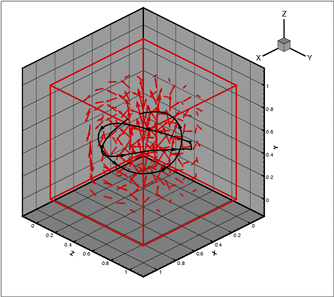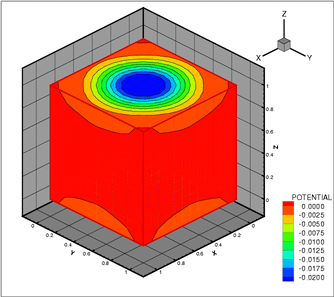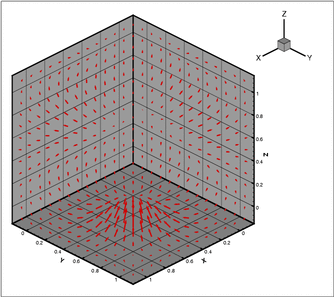Usually, MHD is understood as the forward problem of
determining velocity and magnetic fields in the sense of solving the coupled
system of Navier-Stokes equations and induction equation if some boundary
conditions or types of forcing are given. For most laboratory and
technical applications with small magnetic Reynolds number Rm the
magnetic field is disturbed only slightly by the flow whereas it can modify
the latter significantly via Lorentz forces. For higher Rm, however, the
fluid flow can change the magnetic field drastically or can even lead to
self-excitation of a magnetic field via the dynamo effect.
In the inverse problems approach one strives to get information about
the distribution of certain material parameters or temperature and velocity
fields inside the fluid from measurements of appropriate quantities
at the fluid boundary and/or outside the fluid. We restrict our interest
on the spatial reconstruction of the velocity field (or of related
mean-field quantities) purely from magnetic fields and electric potentials
which can be measured outside the fluid body and at its boundary, respectively.
For the case of small Rm, which is most interesting for a number of
technological applications like metal casting and crystal growth, it is
necessary to apply external magnetic fields and to measure the flow induced
magnetic fields and electric potentials. Analytical results concerning the
uniqueness problem of velocity reconstruction /1/, /2/ as well as numerical
illustrations /3/ have been published recently. As the inverse problem
is ill-posed,
appropriate regularization techniques must be applied. For the sake
of illustration, consider a simple forward problem. Figures 1 shows
a model velocity field in a cube which produces an electric potential
at the fluid boundary (Figure 2) and an additional magnetic field outside
(Figure 3) if it is exposed to an homogeneous magnetic field pointing in
z-direction.
Our goal is now set up an experiment where the unknown
velocity is reconstructed from the measured electric potentials and
induced magnetic fields.

|
| Fig. 1: A model velocity
field consisting of a poloidal and a toroidal part. |

|
| Fig. 2: If the velocity field is
exposed to an homogenious magnetic field pointing in z-direction, an electric
potential is induced at the fluid boundary which can be measured by potential
probes. |

|
| Fig. 3: Outside the fluid, an
additional magnetic field is induced which must be determined on the
background of the external field. |
References:
/1/ Stefani, F., Gerbeth, G.: On the uniqueness of velocity reconstruction
in conducting fluids from measurements of induced electromagnetic fields,
Inverse Problems, 16 (2000), pp. 1-9
/2/ Stefani, F., Gerbeth, G.: A contactless method for velocity
reconstruction in electrically conducting fluids,
Mesurement Science and Technology, 11 (2000), pp. 758-765
/3/ Stefani, F., Gerbeth, G.: Velocity reconstruction in conducting
fluids from magnetic field and electric potential measurements,
Inverse Problems,
15 (1999), pp. 771-786
(14.04.2000) Frank Stefani





